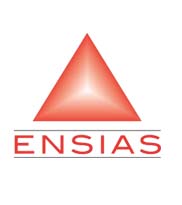- Accueil
-
L'Ecole
-
FORMATIONS
-
FORMATION INGENIEUR
-
Nouvelles filières offertes 2021
- Ingénierie Intélligence Artificielle (2IA)
- Smart Supply Chain & Logistics (2SCL)
- Business Intelligence & Analytics (BI&A)
- Génie de la Data (GD)
- Génie Logiciel (GL)
- Ingénierie Digitale pour la Finance (IDF)
- Smart System Engineering (SSE)
- Ingénierie en Data Science and IOT (IDSIT)
- Sécurité des Systèmes d’Information (SSI)
- REGLEMENT DES ETUDES DE L’ENSIAS CYCLE INGENIEUR
-
Nouvelles filières offertes 2021
-
FORMATION MASTER
- Master de recherche Bioinformatique et Modélisation des Systèmes Complexes Appliquée à la Santé.
- Master Internet des Objets : Logiciel et Analytique (MIOLA)
- Master Recherche en Science de Données et Big Data
- Nouveau Master de Recherche en Sécurité Systèmes et Services (M3S)
- NOUVEAU Master de Recherche : Cloud and high Performance Computing (CLOUDHPC)
-
FORMATION INGENIEUR
- FORMATION CONTINUE
-
Recherche
- INTERNATIONAL
- ENTREPRISES
- VIE ESTUDIANTINE
- BIBLIOTHEQUE
LES DERNIÈRES INFORMATIONS
Classification techniques in breast cancer diagnosis: A systematic literature review
| Titre | Classification techniques in breast cancer diagnosis: A systematic literature review |
| Publication Type | Journal Article |
| Year of Publication | 2021 |
| Authors | ElOuassif, B, Idri, A, Hosni, M, Abran, A |
| Journal | Computer Methods in Biomechanics and Biomedical Engineering: Imaging and Visualization |
| Volume | 9 |
| Pagination | 50-77 |
| Mots-clés | Article, Artificial intelligence, artificial neural network, Breast Cancer, Breast cancer diagnosis, cancer diagnosis, cause of death, Causes of death, Classification (of information), Classification technique, Comparison of performance, Computer aided diagnosis, data extraction, Data mining, data synthesis, decision tree, Decision trees, Diseases, human, k nearest neighbor, Machine learning, Medical fields, Medical informatics, Network support, Neural networks, publication, qualitative research, Quality control, support vector machine, Support vector machine classifiers, Support vector machines, Support vectors machine, Systematic literature review, Systematic Review, validity |
| Abstract | Data mining (DM) consists in analysing a set of observations to find unsuspected relationships and then summarising the data in new ways that are both understandable and useful. It has become widely used in various medical fields including breast cancer (BC), which is the most common cancer and the leading cause of death among women worldwide. BC diagnosis is a challenging medical task and many studies have attempted to apply classification techniques to it. The objective of the present study is to identify studies on classification techniques in BC diagnosis and to analyse them from three perspectives: classification techniques used, accuracy of the classifiers, and comparison of performance. We performed a systematic literature review (SLR) of 176 selected studies published between January 2000 and November 2018. The results show that, of the nine classification techniques investigated, artificial neural networks, support vector machines and decision trees were the most frequently used. Moreover, artificial neural networks, support vector machines and ensemble classifiers performed better than the other techniques, with median accuracy values of 95%, 95% and 96% respectively. Most of the selected studies (57.4%) used datasets containing different types of images such as mammographic, ultrasound, and microarray images. © 2021 Informa UK Limited, trading as Taylor & Francis Group. |
| URL | https://www.scopus.com/inward/record.uri?eid=2-s2.0-85098842973&doi=10.1080%2f21681163.2020.1811159&partnerID=40&md5=9a48998b1c44d263863efcfb25f9920f |
| DOI | 10.1080/21681163.2020.1811159 |
Revues:
LIENS UTILES
Localisation
Contactez-nous
ENSIAS
 Avenue Mohammed Ben Abdallah Regragui, Madinat Al Irfane, BP 713, Agdal Rabat, Maroc
Avenue Mohammed Ben Abdallah Regragui, Madinat Al Irfane, BP 713, Agdal Rabat, Maroc
![]() Télécopie : (+212) 5 37 68 60 78
Télécopie : (+212) 5 37 68 60 78
![]() Secrétariat de direction : 06 61 48 10 97
Secrétariat de direction : 06 61 48 10 97
Secrétariat général : 06 61 34 09 27
Service des affaires financières : 06 61 44 76 79
Service des affaires estudiantines : 06 62 77 10 17 / n.mhirich@um5s.net.ma
Résidences : 06 61 82 89 77
Education - This is a contributing Drupal Theme
Design by WeebPal.
Design by WeebPal.



































